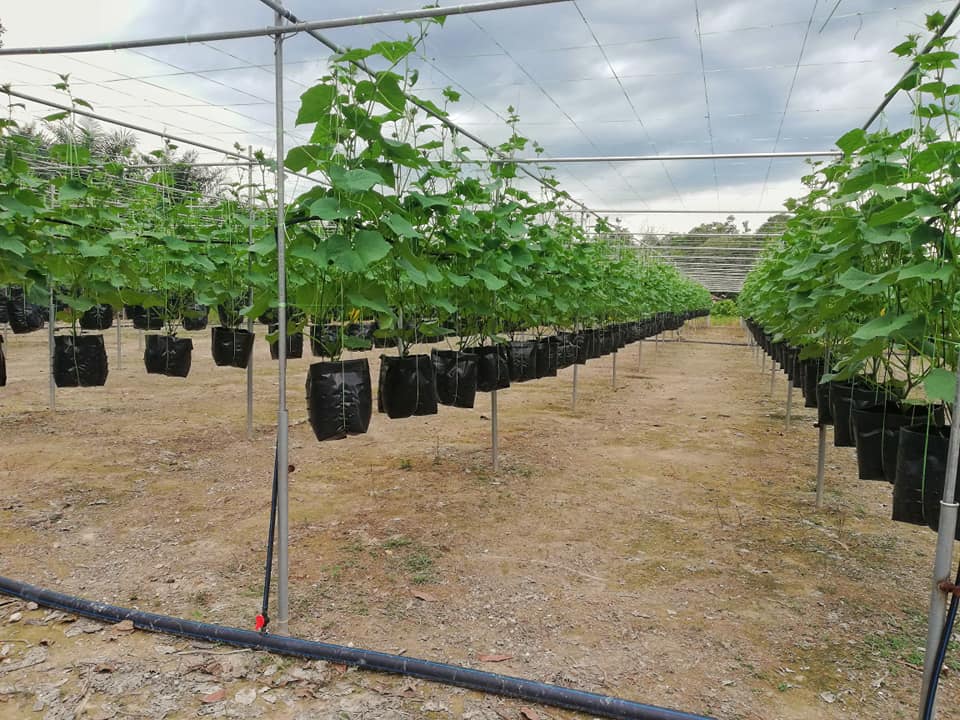By Huraiyah Nabilah binti Zaaday
Fertigation is the injection of fertilizers, used for soil amendments, water amendments and other water-soluble products into an irrigation system. Fertigation is related to chemigation, the injection of chemicals into an irrigation system.
The two terms are sometimes used interchangeably, however, chemigation is generally a more controlled and regulated process due to the nature of the chemicals used.
Fertigation often involves insecticides, herbicides and fungicides, some of which pose health threats to human beings, animals and the environment. But, it is different from the hanging fertigation system. These strategies are appropriate for tricky regions, for example, acidic soils condition, peat soils, ex-tin mining region, bris soils and those regions exposed to flash flood.
This new hanging fertigation framework is ready to reduce assault of soil borne illnesses and harm because of blaze flood, and more yield because of early harvesting (multi week sooner) or longer harvest collecting period by 7-10 days in contrast with the traditional method.
Fertigation is practised extensively in commercial agriculture and horticulture. Fertigation is also increasingly being used for landscaping as dispenser units become more reliable and easier to use. It is also used to add additional nutrients or to correct nutrient deficiencies detected in plant tissue analysis. It is usually practised on high-value crops such as vegetables, turf, fruit trees, and ornamentals.

Negeri Sembilan (Ikmal Safiqraz Abdullah and his wife)
Most plant nutrients can be applied through irrigation systems. Nitrogen is the most commonly used plant nutrient. Naturally occurring nitrogen (N2) is a diatomic molecule which makes up approximately 80 percent of the earth’s atmosphere. Most plants cannot directly consume diatomic nitrogen, therefore, nitrogen must be contained as a component of other chemical substances which plants can consume. Commonly, anhydrous ammonia, ammonium nitrate, and urea are used as bioavailable sources of nitrogen.
Other nutrients needed by plants include phosphorus and potassium. Like nitrogen, plants require these substances to live but they must be contained in other chemical substances such as monoammonium phosphate or diammonium phosphate to serve as bioavailable nutrients. A common source of potassium is muriate of potash which is chemically potassium chloride. A soil fertility analysis is used to determine which of the more stable nutrients should be used.
The benefits of fertigation is that it can increase nutrient absorption by plants and have an accurate placement of nutrients as where the water goes the nutrient goes as well. The ability to “micro dose”, feeding the plants just enough so nutrients can be absorbed and are not left to be washed down to stormwater next time it rains. It can also reduce fertiliser, chemicals, and water needed, reduced leaching of chemicals into the water supply and reduced water consumption due to the plant’s increased root mass’s ability to trap and hold water.
Fertigation assists distribution of fertilisers for farmers. The simplest type of fertigation system consists of a tank with a pump, distribution pipes, capillaries, and a dripper pen. All systems should be placed on a raised or sealed platform, not in direct contact with the earth. Each system should also be fitted with chemical spill trays.
Because of the potential risk of contamination in the potable (drinking) water supply, a back-flow prevention device is required for most fertigation systems. Back-flow requirements may vary greatly. Hence, hanging fertigation should be expanded all over the world. ***
